Structural, magnetic and electrical properties of ho and ni co-Doped bifeo3 materials
Pure BiFeO3 (BFO) and Bi1-xHoxFe0.97Ni0.03O3 (x = 0, 0.025, 0.05, 0.075, and 0.1)
materials were synthesized by a sol-gel method. The influence of (Ho, Ni) co-doping on
structural, magnetic and electrical properties of BFO materials were investigated by different
techniques as X-ray diffraction (XRD), energy dispersion X-ray (EDX), Raman scattering,
magnetic hysteresis (M-H) loops, and complex impedance spectra measurement. XRD results
showed that all samples were crystallized in the rhombohedral structure with R3C space group.
Crystal lattice parameters (a, c) and average crystal size LXRD were (a = 5.584 Å, c = 13.867 Å,
LXRD = 60 nm) for pure BFO, (a = 5.589 Å, c = 13.875 Å, LXRD = 60 nm) for BiFe0.97Ni0.03O3
sample, and then decreased with increasing of Ho content in (Ho, Ni) co-doped samples.
Similarly, Raman scattering spectra showed the left shift of active modes Fe-O bonds when
doping Ni and right shift when co-doping Ho. These observations confirmed the successful
substitution of Ho3+ and Ni2+ ions into the host BFO crystal lattice. Magnetic hysteresis loops
measurement indicated that all samples exhibited weak ferromagnetic behavior with saturation
magnetization Ms and remnant magnetization Mr of (Ms ~ 0.047 emu/g, Mr ~ 0.008 emu/g) for
pure BFO which increased gradually for (Ho, Ni) co-doped samples, reached to (Ms ~ 0.702
emu/g, Mr ~ 0.169 emu/g) for x = 0 sample. Origin of the enhancement of ferromagnetization in
(Ho, Ni) co-doped samples have been discussed.
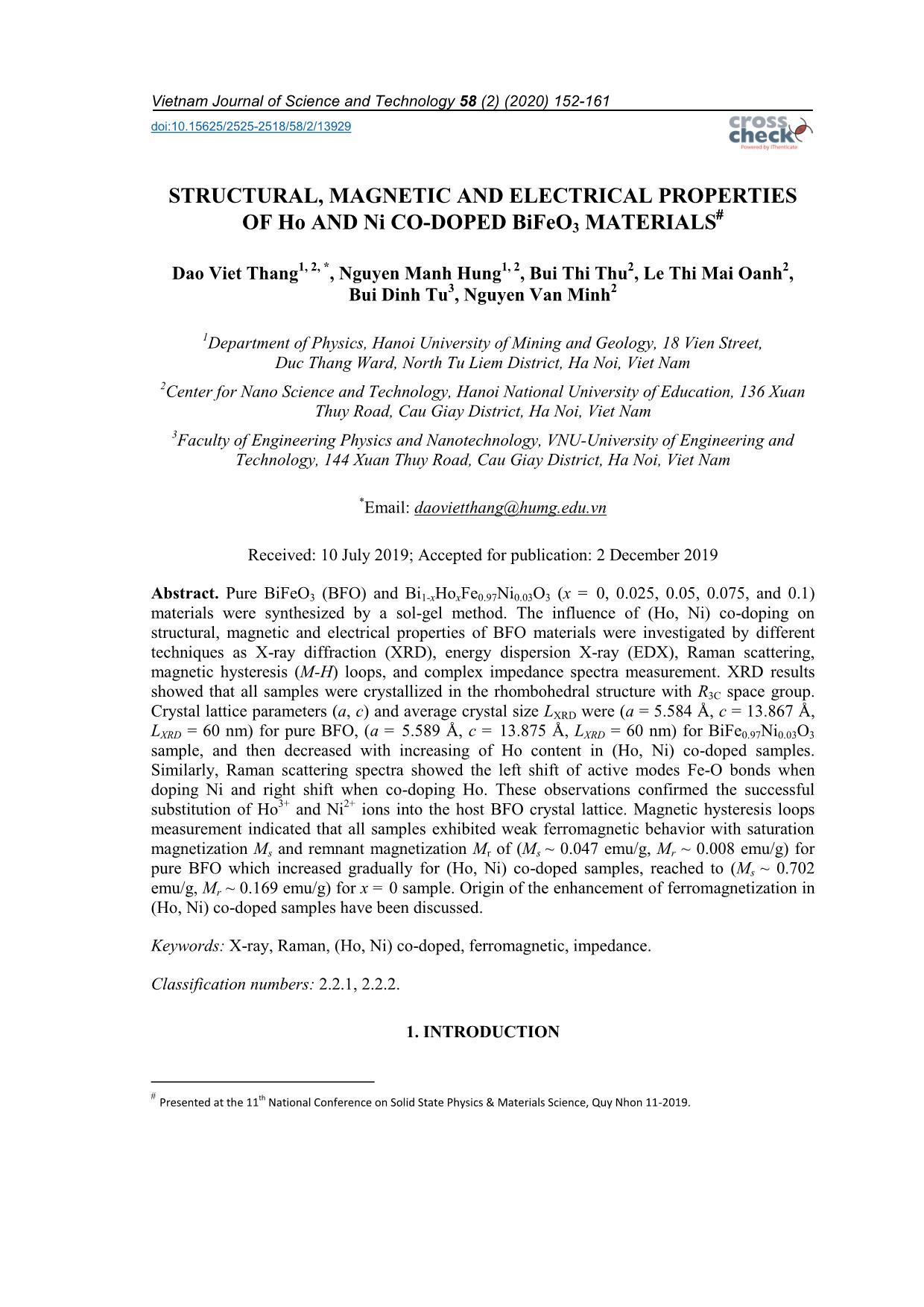
Trang 1
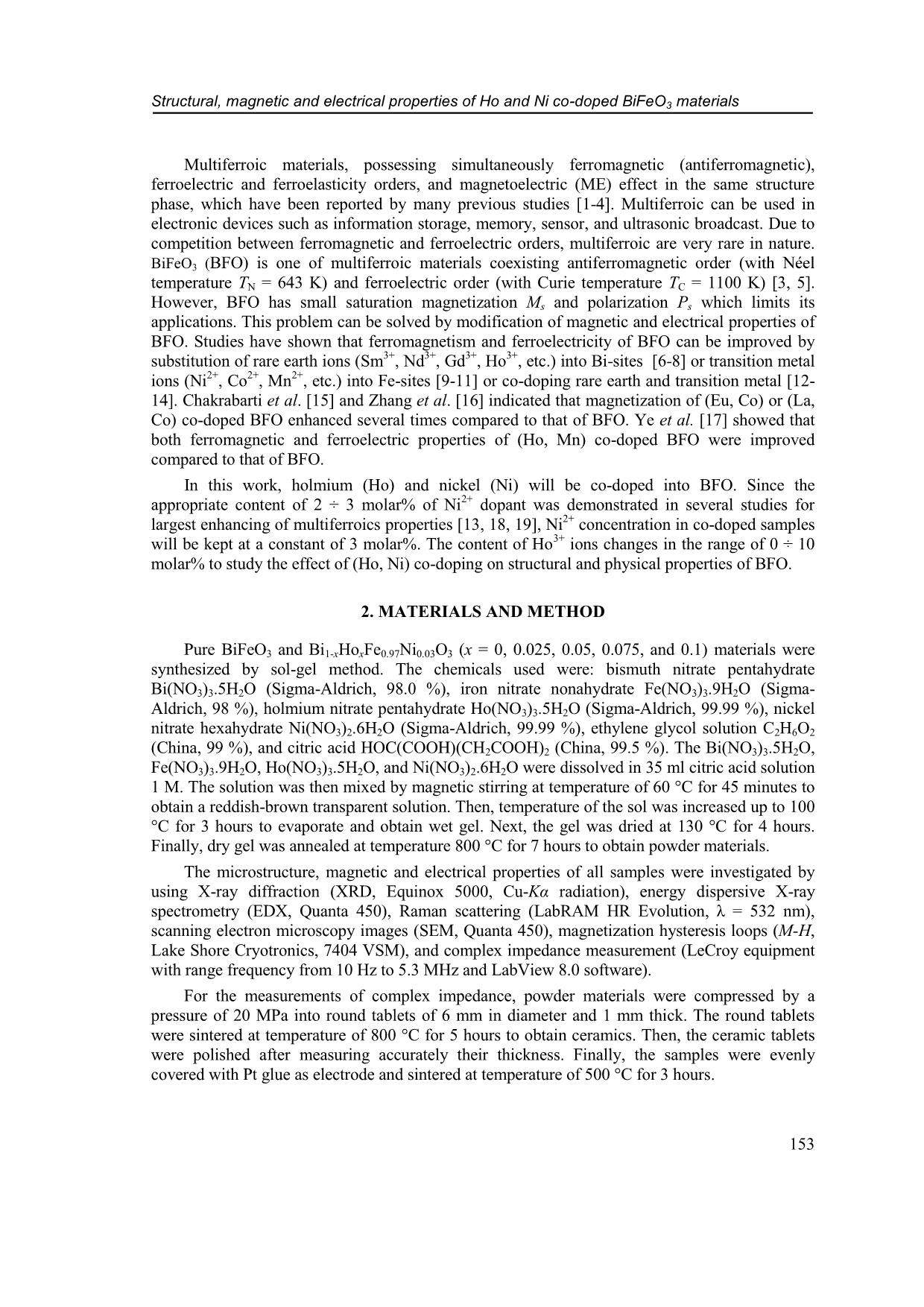
Trang 2
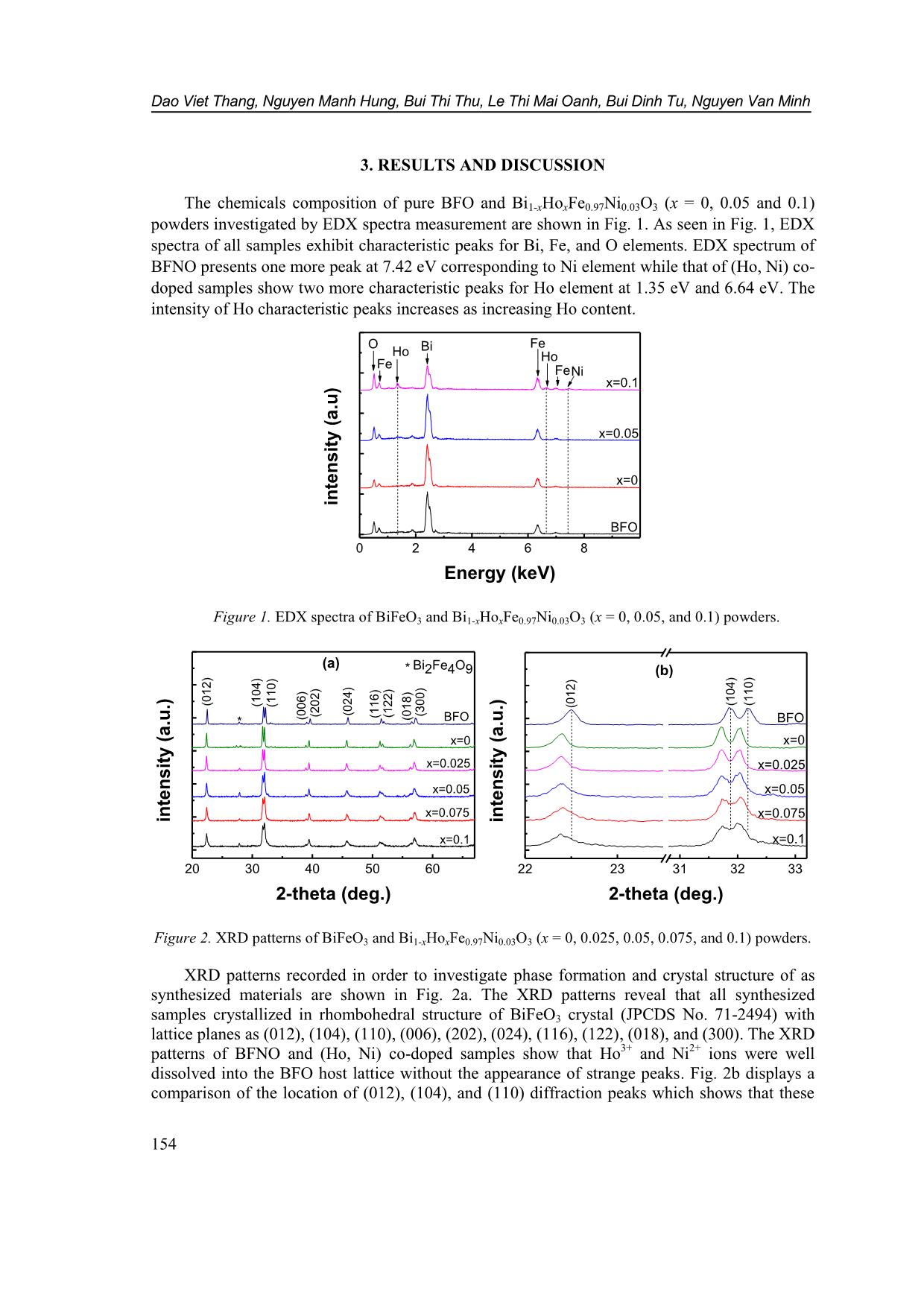
Trang 3
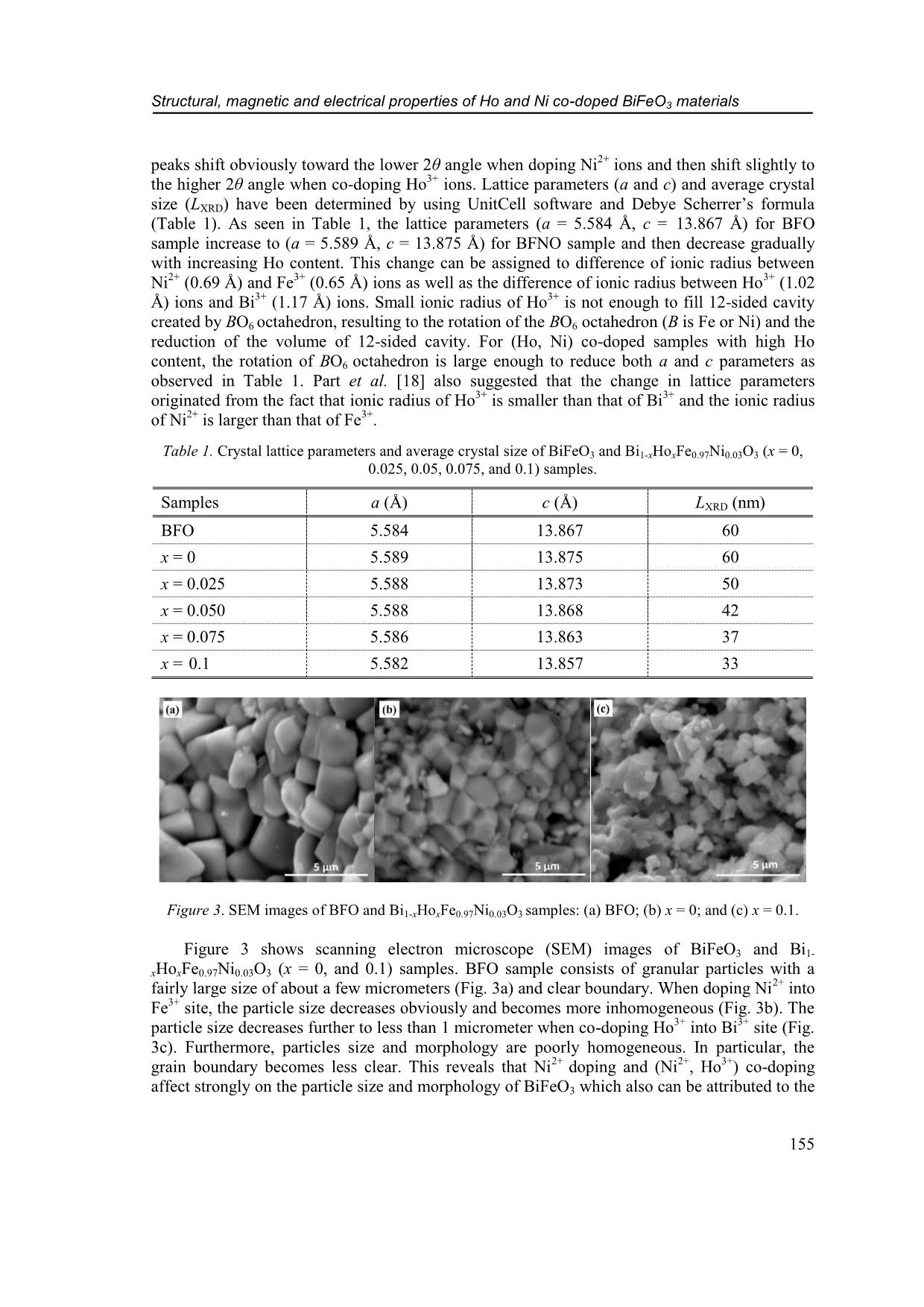
Trang 4
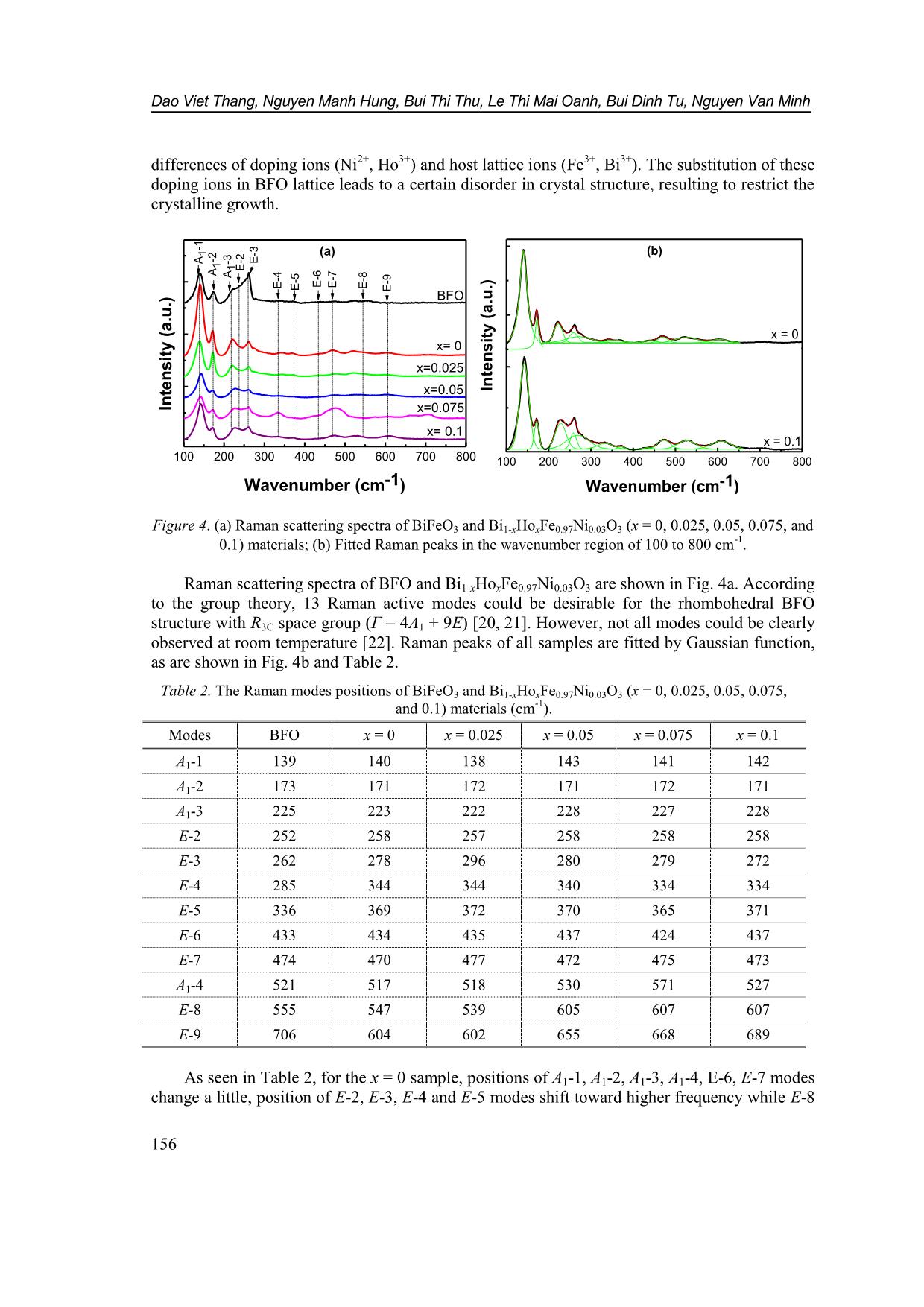
Trang 5

Trang 6
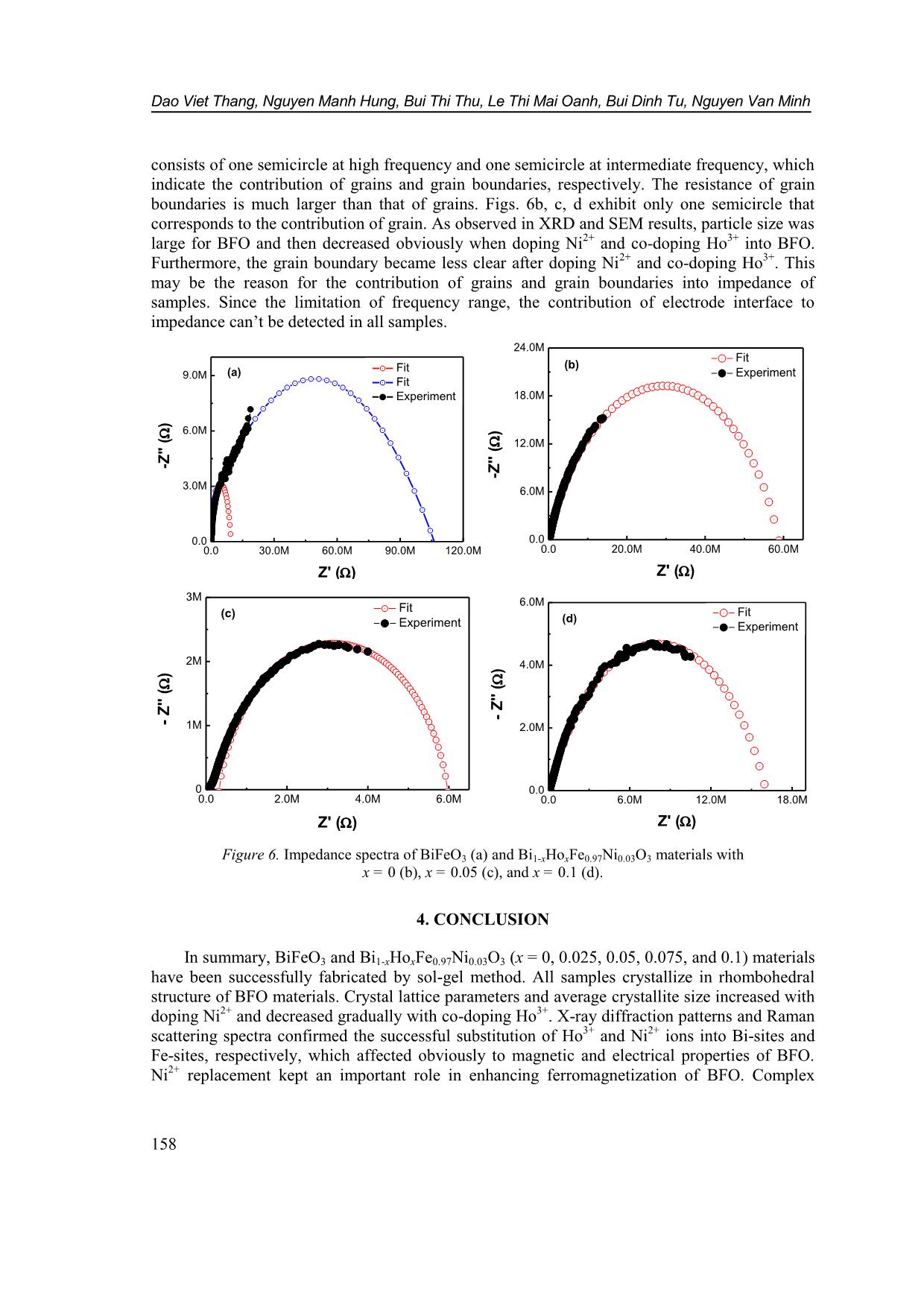
Trang 7
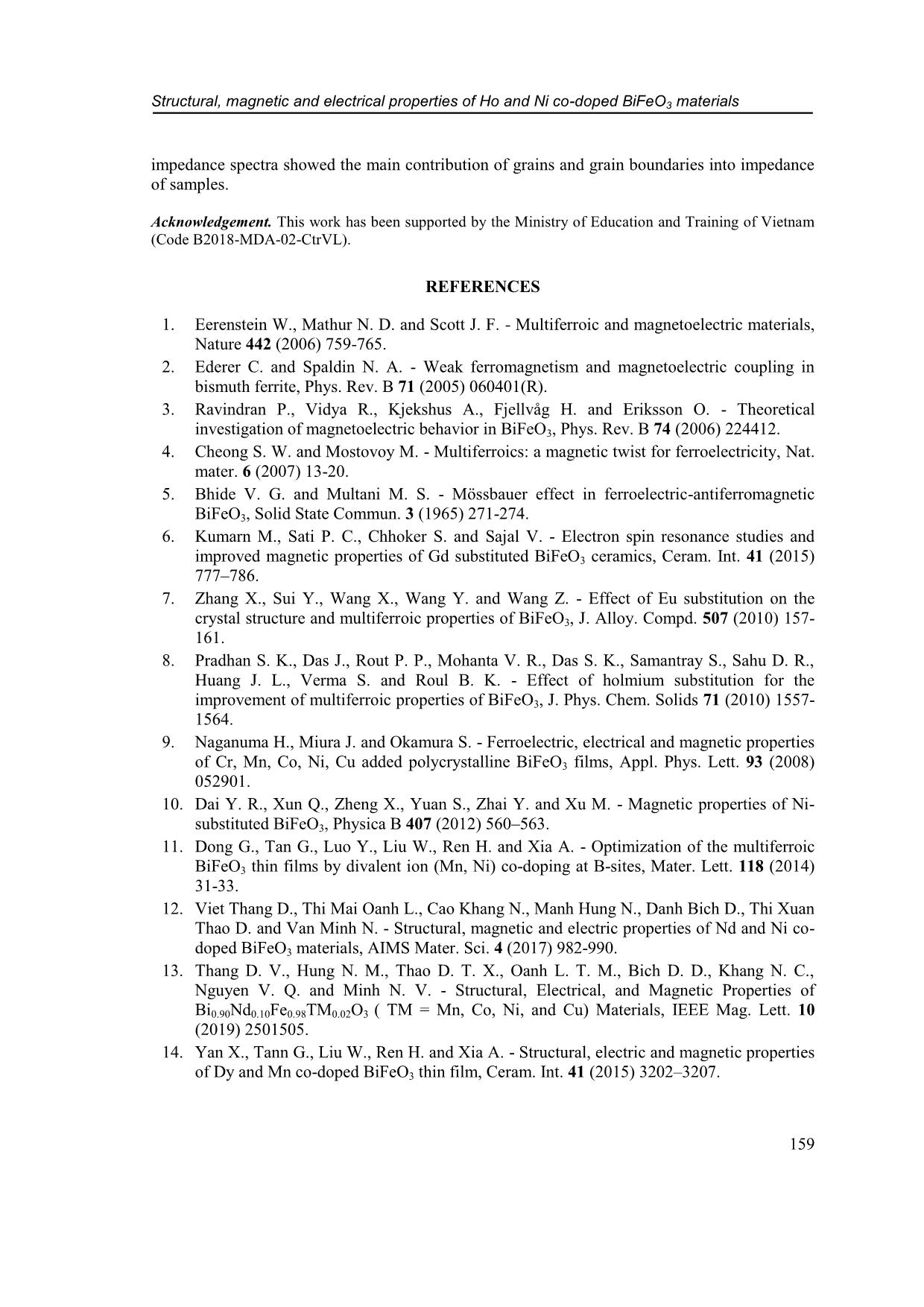
Trang 8
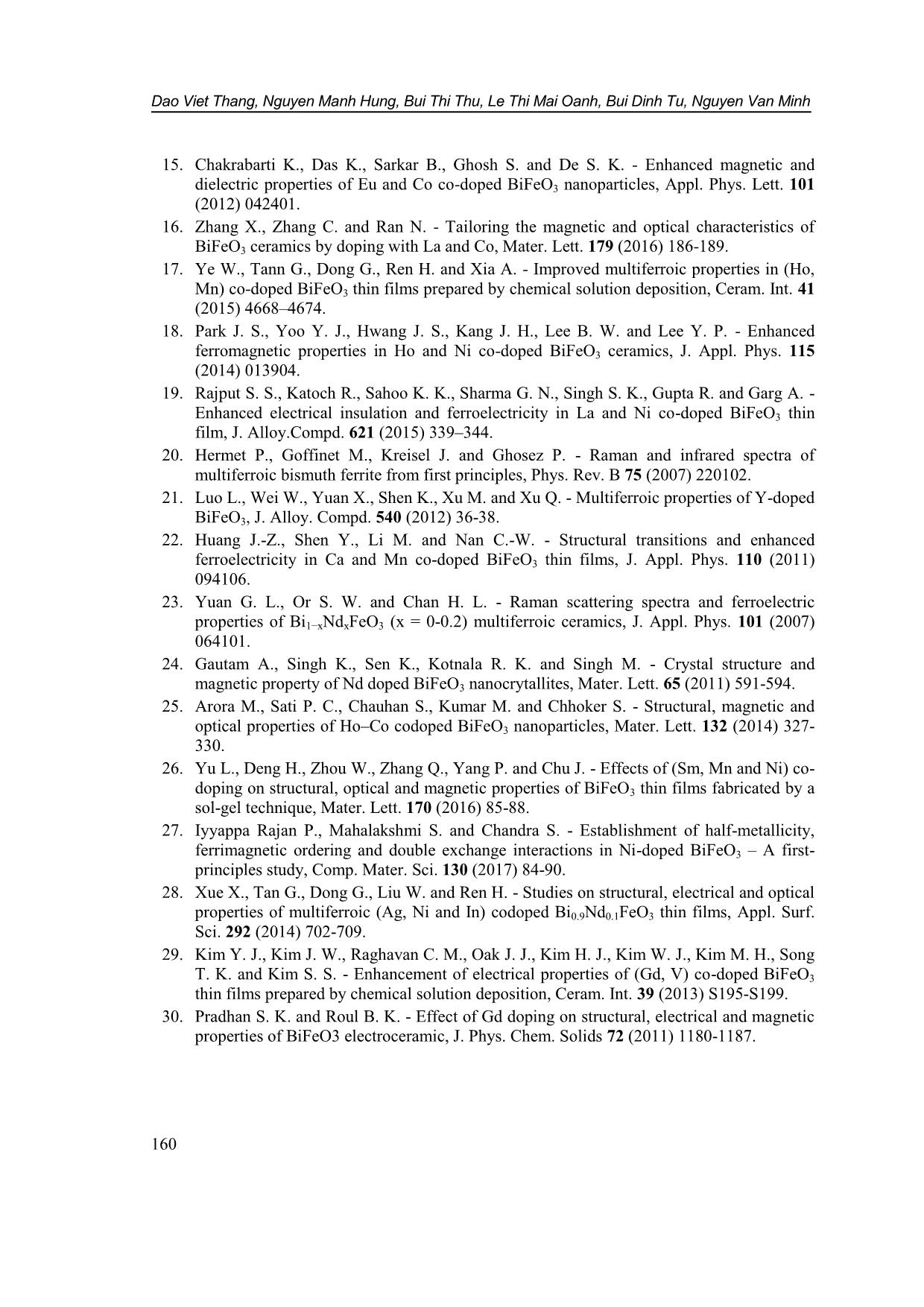
Trang 9
Tóm tắt nội dung tài liệu: Structural, magnetic and electrical properties of ho and ni co-Doped bifeo3 materials
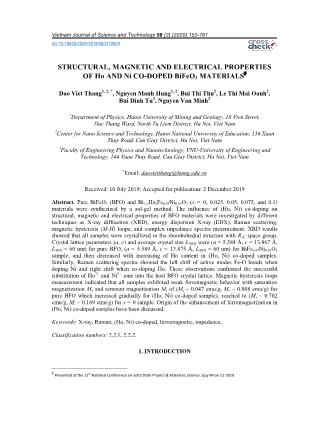
BFO 5.584 13.867 60 x = 0 5.589 13.875 60 x = 0.025 5.588 13.873 50 x = 0.050 5.588 13.868 42 x = 0.075 5.586 13.863 37 x = 0.1 5.582 13.857 33 Figure 3. SEM images of BFO and Bi1-xHoxFe0.97Ni0.03O3 samples: (a) BFO; (b) x = 0; and (c) x = 0.1. Figure 3 shows scanning electron microscope (SEM) images of BiFeO3 and Bi1- xHoxFe0.97Ni0.03O3 (x = 0, and 0.1) samples. BFO sample consists of granular particles with a fairly large size of about a few micrometers (Fig. 3a) and clear boundary. When doping Ni 2+ into Fe 3+ site, the particle size decreases obviously and becomes more inhomogeneous (Fig. 3b). The particle size decreases further to less than 1 micrometer when co-doping Ho 3+ into Bi 3+ site (Fig. 3c). Furthermore, particles size and morphology are poorly homogeneous. In particular, the grain boundary becomes less clear. This reveals that Ni 2+ doping and (Ni 2+ , Ho 3+ ) co-doping affect strongly on the particle size and morphology of BiFeO3 which also can be attributed to the Dao Viet Thang, Nguyen Manh Hung, Bui Thi Thu, Le Thi Mai Oanh, Bui Dinh Tu, Nguyen Van Minh 156 differences of doping ions (Ni 2+ , Ho 3+ ) and host lattice ions (Fe 3+ , Bi 3+ ). The substitution of these doping ions in BFO lattice leads to a certain disorder in crystal structure, resulting to restrict the crystalline growth. Figure 4. (a) Raman scattering spectra of BiFeO3 and Bi1-xHoxFe0.97Ni0.03O3 (x = 0, 0.025, 0.05, 0.075, and 0.1) materials; (b) Fitted Raman peaks in the wavenumber region of 100 to 800 cm -1 . Raman scattering spectra of BFO and Bi1-xHoxFe0.97Ni0.03O3 are shown in Fig. 4a. According to the group theory, 13 Raman active modes could be desirable for the rhombohedral BFO structure with R3C space group (Γ = 4A1 + 9E) [20, 21]. However, not all modes could be clearly observed at room temperature [22]. Raman peaks of all samples are fitted by Gaussian function, as are shown in Fig. 4b and Table 2. As seen in Table 2, for the x = 0 sample, positions of A1-1, A1-2, A1-3, A1-4, E-6, E-7 modes change a little, position of E-2, E-3, E-4 and E-5 modes shift toward higher frequency while E-8 100 200 300 400 500 600 700 800 (a) E -8 E -5 E -4 E -2 E -3 A 1 -3 A 1 -2 x= 0.1 x=0.075 x=0.05 x=0.025 x= 0 In te n s it y ( a .u .) Wavenumber (cm-1) BFO A 1 -1 E -7 E -6 E -9 100 200 300 400 500 600 700 800 Wavenumber (cm-1) In te n s it y ( a .u .) x = 0 x = 0.1 (b) Table 2. The Raman modes positions of BiFeO3 and Bi1-xHoxFe0.97Ni0.03O3 (x = 0, 0.025, 0.05, 0.075, and 0.1) materials (cm -1 ). Modes BFO x = 0 x = 0.025 x = 0.05 x = 0.075 x = 0.1 A1-1 139 140 138 143 141 142 A1-2 173 171 172 171 172 171 A1-3 225 223 222 228 227 228 E-2 252 258 257 258 258 258 E-3 262 278 296 280 279 272 E-4 285 344 344 340 334 334 E-5 336 369 372 370 365 371 E-6 433 434 435 437 424 437 E-7 474 470 477 472 475 473 A1-4 521 517 518 530 571 527 E-8 555 547 539 605 607 607 E-9 706 604 602 655 668 689 Structural, magnetic and electrical properties of Ho and Ni co-doped BiFeO3 materials 157 and E-9 modes shift toward lower frequency in comparison with those of BFO. For the (Ho, Ni) co-doped samples, positions of A1-1, A1-3, A1-4, E-3, E-6, and E-7 modes tend to shift slightly toward higher frequency, positions of E-2, E-4, and E-5 modes change a little, while positions of E-8 and E-9 modes tend to shift strongly toward higher frequency in comparison with those of the x = 0 sample. Previous studies have also showed that the A1 modes and E modes at low frequency characterize for Bi-O covalent bonds, other E modes at high frequency characterize for Fe-O bonds [23]. The A1-1, A1-3, A1-4, E-3, E-6, and E-7 modes characterize for Bi-O covalent bonds [14, 24], while the E-8, E-9 modes characterize for Fe-O bonds [11, 25]. So the changes of E-8, E-9 modes confirmed Ni 2+ ions substituted into Fe-sites, and the changes of A1- 1, A1-2, A1-3, A1-4, E-3, E-6 and E-7 confirmed Ho 3+ ions substituted into Bi-sites. These results are conformable to the XRD results, which confirmed that Ho 3+ and Ni 2+ ions substituted into Bi-sites and Fe-sites, respectively. Figure 5. (a) Magnetic hysteresis loops of BiFeO3 and Bi1-xHoxFe0.97Ni0.03O3 materials; (b) Dependence of saturation magnetization and remnant magnetization on concentration of Ho. Figure 5a shows magnetic hysteresis loops of BFO and Bi1-xHoxFe0.97Ni0.03O3 materials at room temperature. As seen in Fig. 5a, all samples present weak ferromagnetic behavior. BFO sample has saturation magnetization of Ms = 0.047 emu/g and remanent magnetization of Mr = 0.008 emu/g. When doping with Ni 2+ ions in Fe 3+ site, Ms and Mr values increase to 0.702 emu/g and 0.169 emu/g, respectively. However, when co-doping Ho 3+ in Bi 3+ site they decrease slightly as observed in Fig. 5b. This reveals that Ni 2+ doping enhances ferromagnetization in BFO that can be attributed to some following reasons: (i) the appearance of ferrimagnetic order Ni 2+ -O 2- - Fe 3+ besides antiparallel indirect interaction between Fe 3+ and neighbor Fe 3+ [26, 27]; (ii) Ni 2+ replacement in Fe 3+ site causes the charge shortage, in order to neutralize the charge, some Fe 3+ ions transform to Fe 4+ , resulting the ferromagnetic double exchange interaction Fe 3+ -O 2- - Fe 4+ ; (iii) the enhancement of magnetization due to the appearance of oxygen vacancies and lattice defects when doping Ni 2+ in BFO lattice [28]. The slight decrease of saturation magnetization and remanent magnetization in (Ho, Ni) co-doped samples in Fig. 5b could be explained by the reduction of oxygen vacancies due to Bi 3+ volatilization [29, 30]. However, the Ms and Mr values in (Ho, Ni) co-doped samples are still larger 12 and 15 times in comparison with those of BFO. Figure 6 shows complex impedance spectra of BiFeO3 and Bi1-xHoxFe0.97Ni0.03O3 (x = 0, 0.05, and 0.1) which can indicate the contribution of grain, grain boundaries, and electrode interface into impedance of materials. As can be seen, simulated curves fit well with the experimental curves in all samples. Fig. 6a presents that the impedance spectrum of BFO -4000 -2000 0 2000 4000 -0.5 0.0 0.5 -200 -100 0 100 200 -0.3 -0.2 -0.1 0.0 0.1 0.2 0.3 M ( e m u /g ) H (Oe) M ( e m u /g ) H (Oe) BFO x=0 x=0.025 x=0.05 x=0.075 x=0.1 (a) 0.000 0.025 0.050 0.075 0.100 0.0 0.2 0.4 0.6 0.8 M ( e m u /g ) Ho content Ms Mr (b) BFO Dao Viet Thang, Nguyen Manh Hung, Bui Thi Thu, Le Thi Mai Oanh, Bui Dinh Tu, Nguyen Van Minh 158 consists of one semicircle at high frequency and one semicircle at intermediate frequency, which indicate the contribution of grains and grain boundaries, respectively. The resistance of grain boundaries is much larger than that of grains. Figs. 6b, c, d exhibit only one semicircle that corresponds to the contribution of grain. As observed in XRD and SEM results, particle size was large for BFO and then decreased obviously when doping Ni 2+ and co-doping Ho 3+ into BFO. Furthermore, the grain boundary became less clear after doping Ni 2+ and co-doping Ho 3+ . This may be the reason for the contribution of grains and grain boundaries into impedance of samples. Since the limitation of frequency range, the contribution of electrode interface to impedance can’t be detected in all samples. Figure 6. Impedance spectra of BiFeO3 (a) and Bi1-xHoxFe0.97Ni0.03O3 materials with x = 0 (b), x = 0.05 (c), and x = 0.1 (d). 4. CONCLUSION In summary, BiFeO3 and Bi1-xHoxFe0.97Ni0.03O3 (x = 0, 0.025, 0.05, 0.075, and 0.1) materials have been successfully fabricated by sol-gel method. All samples crystallize in rhombohedral structure of BFO materials. Crystal lattice parameters and average crystallite size increased with doping Ni 2+ and decreased gradually with co-doping Ho 3+ . X-ray diffraction patterns and Raman scattering spectra confirmed the successful substitution of Ho 3+ and Ni 2+ ions into Bi-sites and Fe-sites, respectively, which affected obviously to magnetic and electrical properties of BFO. Ni 2+ replacement kept an important role in enhancing ferromagnetization of BFO. Complex 0.0 30.0M 60.0M 90.0M 120.0M 0.0 3.0M 6.0M 9.0M -Z " ( ) Z' () Fit Fit Experiment (a) 0.0 20.0M 40.0M 60.0M 0.0 6.0M 12.0M 18.0M 24.0M -Z '' ( ) Z' () Fit Experiment (b) 0.0 2.0M 4.0M 6.0M 0 1M 2M 3M - Z '' ( ) Z' () Fit Experiment (c) 0.0 6.0M 12.0M 18.0M 0.0 2.0M 4.0M 6.0M - Z '' ( ) Z' () Fit Experiment (d) Structural, magnetic and electrical properties of Ho and Ni co-doped BiFeO3 materials 159 impedance spectra showed the main contribution of grains and grain boundaries into impedance of samples. Acknowledgement. This work has been supported by the Ministry of Education and Training of Vietnam (Code B2018-MDA-02-CtrVL). REFERENCES 1. Eerenstein W., Mathur N. D. and Scott J. F. - Multiferroic and magnetoelectric materials, Nature 442 (2006) 759-765. 2. Ederer C. and Spaldin N. A. - Weak ferromagnetism and magnetoelectric coupling in bismuth ferrite, Phys. Rev. B 71 (2005) 060401(R). 3. Ravindran P., Vidya R., Kjekshus A., Fjellvåg H. and Eriksson O. - Theoretical investigation of magnetoelectric behavior in BiFeO3, Phys. Rev. B 74 (2006) 224412. 4. Cheong S. W. and Mostovoy M. - Multiferroics: a magnetic twist for ferroelectricity, Nat. mater. 6 (2007) 13-20. 5. Bhide V. G. and Multani M. S. - Mössbauer effect in ferroelectric-antiferromagnetic BiFeO3, Solid State Commun. 3 (1965) 271-274. 6. Kumarn M., Sati P. C., Chhoker S. and Sajal V. - Electron spin resonance studies and improved magnetic properties of Gd substituted BiFeO3 ceramics, Ceram. Int. 41 (2015) 777–786. 7. Zhang X., Sui Y., Wang X., Wang Y. and Wang Z. - Effect of Eu substitution on the crystal structure and multiferroic properties of BiFeO3, J. Alloy. Compd. 507 (2010) 157- 161. 8. Pradhan S. K., Das J., Rout P. P., Mohanta V. R., Das S. K., Samantray S., Sahu D. R., Huang J. L., Verma S. and Roul B. K. - Effect of holmium substitution for the improvement of multiferroic properties of BiFeO3, J. Phys. Chem. Solids 71 (2010) 1557- 1564. 9. Naganuma H., Miura J. and Okamura S. - Ferroelectric, electrical and magnetic properties of Cr, Mn, Co, Ni, Cu added polycrystalline BiFeO3 films, Appl. Phys. Lett. 93 (2008) 052901. 10. Dai Y. R., Xun Q., Zheng X., Yuan S., Zhai Y. and Xu M. - Magnetic properties of Ni- substituted BiFeO3, Physica B 407 (2012) 560–563. 11. Dong G., Tan G., Luo Y., Liu W., Ren H. and Xia A. - Optimization of the multiferroic BiFeO3 thin films by divalent ion (Mn, Ni) co-doping at B-sites, Mater. Lett. 118 (2014) 31-33. 12. Viet Thang D., Thi Mai Oanh L., Cao Khang N., Manh Hung N., Danh Bich D., Thi Xuan Thao D. and Van Minh N. - Structural, magnetic and electric properties of Nd and Ni co- doped BiFeO3 materials, AIMS Mater. Sci. 4 (2017) 982-990. 13. Thang D. V., Hung N. M., Thao D. T. X., Oanh L. T. M., Bich D. D., Khang N. C., Nguyen V. Q. and Minh N. V. - Structural, Electrical, and Magnetic Properties of Bi0.90Nd0.10Fe0.98TM0.02O3 ( TM = Mn, Co, Ni, and Cu) Materials, IEEE Mag. Lett. 10 (2019) 2501505. 14. Yan X., Tann G., Liu W., Ren H. and Xia A. - Structural, electric and magnetic properties of Dy and Mn co-doped BiFeO3 thin film, Ceram. Int. 41 (2015) 3202–3207. Dao Viet Thang, Nguyen Manh Hung, Bui Thi Thu, Le Thi Mai Oanh, Bui Dinh Tu, Nguyen Van Minh 160 15. Chakrabarti K., Das K., Sarkar B., Ghosh S. and De S. K. - Enhanced magnetic and dielectric properties of Eu and Co co-doped BiFeO3 nanoparticles, Appl. Phys. Lett. 101 (2012) 042401. 16. Zhang X., Zhang C. and Ran N. - Tailoring the magnetic and optical characteristics of BiFeO3 ceramics by doping with La and Co, Mater. Lett. 179 (2016) 186-189. 17. Ye W., Tann G., Dong G., Ren H. and Xia A. - Improved multiferroic properties in (Ho, Mn) co-doped BiFeO3 thin films prepared by chemical solution deposition, Ceram. Int. 41 (2015) 4668–4674. 18. Park J. S., Yoo Y. J., Hwang J. S., Kang J. H., Lee B. W. and Lee Y. P. - Enhanced ferromagnetic properties in Ho and Ni co-doped BiFeO3 ceramics, J. Appl. Phys. 115 (2014) 013904. 19. Rajput S. S., Katoch R., Sahoo K. K., Sharma G. N., Singh S. K., Gupta R. and Garg A. - Enhanced electrical insulation and ferroelectricity in La and Ni co-doped BiFeO3 thin film, J. Alloy.Compd. 621 (2015) 339–344. 20. Hermet P., Goffinet M., Kreisel J. and Ghosez P. - Raman and infrared spectra of multiferroic bismuth ferrite from first principles, Phys. Rev. B 75 (2007) 220102. 21. Luo L., Wei W., Yuan X., Shen K., Xu M. and Xu Q. - Multiferroic properties of Y-doped BiFeO3, J. Alloy. Compd. 540 (2012) 36-38. 22. Huang J.-Z., Shen Y., Li M. and Nan C.-W. - Structural transitions and enhanced ferroelectricity in Ca and Mn co-doped BiFeO3 thin films, J. Appl. Phys. 110 (2011) 094106. 23. Yuan G. L., Or S. W. and Chan H. L. - Raman scattering spectra and ferroelectric properties of Bi1−xNdxFeO3 (x = 0-0.2) multiferroic ceramics, J. Appl. Phys. 101 (2007) 064101. 24. Gautam A., Singh K., Sen K., Kotnala R. K. and Singh M. - Crystal structure and magnetic property of Nd doped BiFeO3 nanocrytallites, Mater. Lett. 65 (2011) 591-594. 25. Arora M., Sati P. C., Chauhan S., Kumar M. and Chhoker S. - Structural, magnetic and optical properties of Ho–Co codoped BiFeO3 nanoparticles, Mater. Lett. 132 (2014) 327- 330. 26. Yu L., Deng H., Zhou W., Zhang Q., Yang P. and Chu J. - Effects of (Sm, Mn and Ni) co- doping on structural, optical and magnetic properties of BiFeO3 thin films fabricated by a sol-gel technique, Mater. Lett. 170 (2016) 85-88. 27. Iyyappa Rajan P., Mahalakshmi S. and Chandra S. - Establishment of half-metallicity, ferrimagnetic ordering and double exchange interactions in Ni-doped BiFeO3 – A first- principles study, Comp. Mater. Sci. 130 (2017) 84-90. 28. Xue X., Tan G., Dong G., Liu W. and Ren H. - Studies on structural, electrical and optical properties of multiferroic (Ag, Ni and In) codoped Bi0.9Nd0.1FeO3 thin films, Appl. Surf. Sci. 292 (2014) 702-709. 29. Kim Y. J., Kim J. W., Raghavan C. M., Oak J. J., Kim H. J., Kim W. J., Kim M. H., Song T. K. and Kim S. S. - Enhancement of electrical properties of (Gd, V) co-doped BiFeO3 thin films prepared by chemical solution deposition, Ceram. Int. 39 (2013) S195-S199. 30. Pradhan S. K. and Roul B. K. - Effect of Gd doping on structural, electrical and magnetic properties of BiFeO3 electroceramic, J. Phys. Chem. Solids 72 (2011) 1180-1187.
File đính kèm:
 structural_magnetic_and_electrical_properties_of_ho_and_ni_c.pdf
structural_magnetic_and_electrical_properties_of_ho_and_ni_c.pdf

